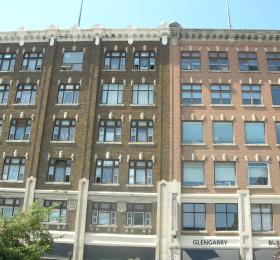Glengarry Block
- Regular
Description of Historic Place
The Glengarry Block (shown on the right) is a six-storey brick building that was constructed in 1913. Also known as the McMillan Block, the commercial building is located at 245 3rd Avenue South in downtown Saskatoon. The building is considered to be an architectural landmark along 3rd Avenue South due to its large scale appearance and the similarities associated with the adjacent building, the Connaught Block.
Heritage Value
Designed by David Webster, the Glengarry Block has a buff brick exterior with Tyndall stone accents. Brick and Tyndall stone pilasters are located on each outside corner of the building. The flat parapet roof features an entablature of cornice and modillions of painted metal. Arched pediments surmount the entablature above the pilasters, and set behind these are domed cupola ornaments. The large windows feature Tyndall stone keystones and sills, and angled corner blocks. The building is nearly identical to the Connaught Block, located next door, differing only in pediments at the roofline, and the arcaded cupola ornaments.
In addition to its architecture, the heritage value of the Glengarry Block lies in its association with Angus McMillan and Frederick Blain, original owners of the Glengarry and the Connaught Block, respectively. The basements of the two buildings, which were built together, were separated by a parting wall. McMillan's portion of the building had a well-lit basement and ground floor to accommodate a restaurant, while Blain's portion of the building was divided into stores and offices. McMillan’s half of the building is now referred to as the Glengarry Block, and Blain’s half of the building is referenced as the Connaught Block.
Today, the Glengarry Block continues to be symbolic of the building boom that occurred during Saskatoon’s boom time period.
Source: City of Saskatoon Built Heritage Database
Character Defining Elements
Key elements which contribute to the heritage value of this historic resource include:
- Its architecture, evident in: its brick facade and Tyndall stone accents; its pilasters; flat parapet roof with entablature of cornice and modillions; arched pediments; cupola ornaments; window keystones, sills, and corner blocks; and
- Those features that speak to its historical association with the Connaught Block, including its original location in the city’s downtown and proximity to the Connaught Block building.

